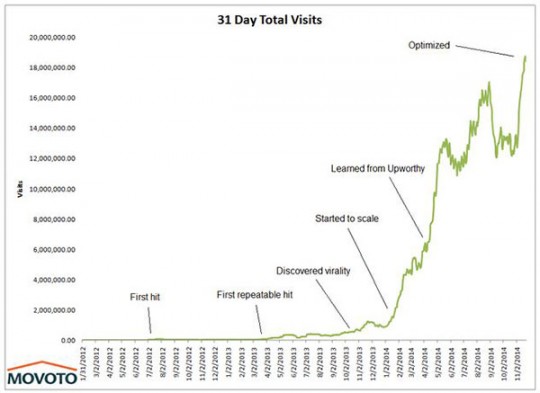Magic Math: You Can Double Your Results in 43 Days
How would it change your business if you could get twice the leads, subscriptions, or sales from your website?
Believe it or not, you can accomplish that goal in less time than you expect and without spending lots of money. The strategy isn’t one of bold, dramatic change. Rather, it’s a strategy composed of small wins that stack up to produce big gains.
Get a headstart on doubling your results! Grab my free guide, 43 Easy Wins to Double Your Website Results, by clicking here!
How Small Wins Snowball Into Huge Success
When I was speaking at Nir Eyal‘s excellent Habit Summit at Stanford, I had a chance to hear and meet personal improvement expert James Clear. He’s an advocate of doing a lot of things in your life just 1% better. It’s hard to make big leaps in performance, but 1% almost always seems achievable.
One of Clear’s favorite stories involves Dave Brailsford, who took over the coaching position at the British professional cycling team in 2010. It was a daunting task – despite the geographic proximity, no British cyclist had ever won the world’s premier cycling event, the Tour de France.
Brailsford naturally instituted a strong training and practice program for team members.
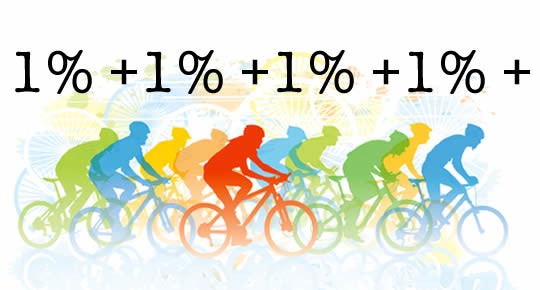
But, then he did something else. As Clear describes it, the coach felt that small improvements in other areas would lead to a win:
They searched for 1 percent improvements in tiny areas that were overlooked by almost everyone else: discovering the pillow that offered the best sleep and taking it with them to hotels, testing for the most effective type of massage gel, and teaching riders the best way to wash their hands to avoid infection. They searched for 1 percent improvements everywhere.
The results came faster than expected. Riders from the Brailsford’s team won the Tour de France in 2012 and 2013, and dominated the 2012 Olympics.
Small marginal gains add up, and do so exponentially, as Clear illustrates:
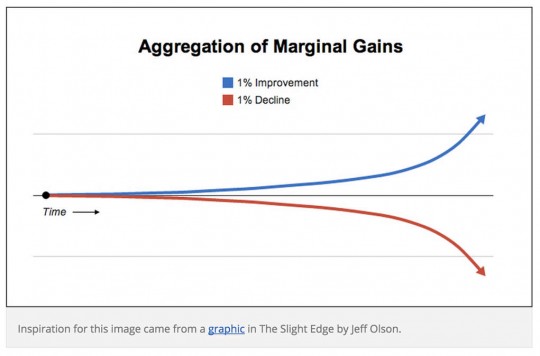
Kaizen – Continuous Improvement

This concept isn’t unlike kaizen, the continuous improvement process famously employed by Japanese automakers in their surge to prominence in the 1980s.
They didn’t build super-automated factories or dramatically redesign their cars. Rather, by continuously making small improvements they surpassed their larger, more established competitors.
The Psychology of the Big Win
I’ve worked in and with big companies, and one common failing is that they frequently focus on big, high-ROI projects. There’s nothing wrong with such projects. If a company can pour a bunch of money into a project and earn it back quickly, that’s great for everyone involved.
The problem with this focus on big winners is that small projects, or even activities not big enough to be called projects, get neglected.
Why do big companies fail to embrace small wins? There are two common objections:
- The ROI is small and/or uncertain. (Try calculating the ROI on a small UX project, for example.)
- Even if it works, the benefit is “too small to make a difference.” (When your revenue target is increasing by millions, projects measured in thousands seem like mere distractions.)
Big companies want big wins that will “move the needle.” Very few internalize the lessons of kaizen and apply them to their marketing.
To use a sports metaphor, big companies want to swing for the fence and hit home runs. Shaving a fraction of a second off base-running times seems, by comparison, trivial and unimportant.
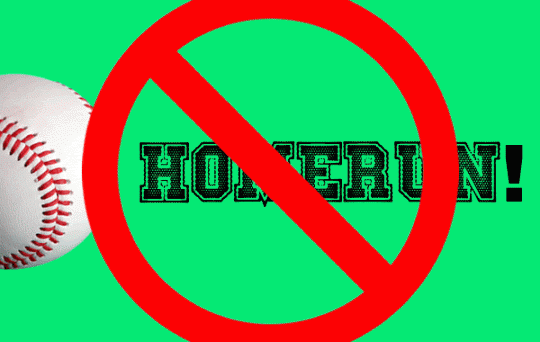
What if a Fortune 500 CEO had been put in charge of the British cyclists? My guess is that there would have been none of that better pillows or massage gel nonsense. These would be mere distractions from important efforts.
More likely, a big R&D project to develop a faster bike would ensue. That, and perhaps a new training program using the latest kinesiology research. Those are the kind of things that make a real difference, right?
When you focus only on big projects with a fast return, you miss many opportunities for small changes that, over time, will add up to big improvement.
Magic Math, a.k.a. Incremental Gains

Obviously, the “1%” improvement isn’t literal, at least in most cases.
I’m sure it was impossible to quantify the effect of a better pillow on cyclist performance. Maybe it was 1%. Maybe it had a bigger impact, or did nothing at all.
For the sake of argument, let’s say that if you make five small changes on your website, you’ll see a distribution something like this:
- 1%
- 5%
- 1%
- 0%
- 1%
That assumes three tweaks will have a tiny 1% impact, one will do better at 5%, and one won’t work at all. That’s no easier to justify than steady 1% improvements but, to me at least, it has more of a “real world” feel.
With this pattern of modest, incremental improvement, how many tweaks would it take to double your results?
To put it another way, if you could do one small thing each and every day, how long would it take to achieve 100% better results than you are right now?
The answer may surprise you.
If you average one small change per day with the 1%-5%-1%-0%-1% pattern, in less than a month you’ll see a 50% improvement.
And, you’ll double your results in just 43 days. That’s a month and a half.
Here’s the graph:
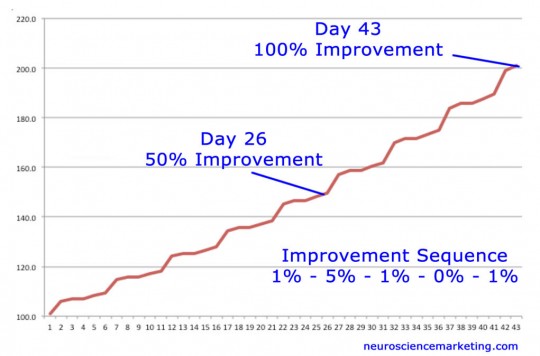
Note that the exponential phase has barely kicked in at this point. Most of the change is linear.
If you keep going, the impact of each gain is magnified. In less than 5 months, if you could sustain this pace, your results would theoretically be 10 times higher. That’s a big “if,” though…
The Bad News
There is a problem with extending this calculation for too long.
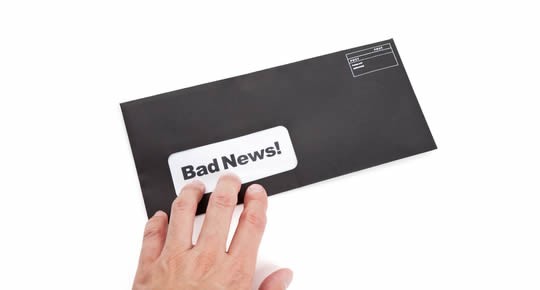
You’ll likely find that diminishing returns begin to set in. The small changes you make later on just won’t have the same impact as the early ones. You will probably have exhausted the “low hanging fruit,” i.e., those changes that are easy to make, have a significant impact, and will probably work.
You may even run out of good ideas. (I’ve got a solution for that – grab my free 43 Easy Wins guide to get at least a few ideas you haven’t thought of.)
Sites that are already busy and have been well-optimized will have fewer obvious tweaks and will be more challenging to keep on the marginal gain curve.
So, as compelling as the math is, the odds of you hitting that 10x improvement in just a few months are low. The steeper areas of the curve may require better tweaks with bigger absolute magnitudes.
The fact is that most exponential curves don’t keep going – they almost all run out of steam at some point.
The Good News
The math of exponential growth may catch up with you eventually, but in the short term you may actually be able to get ahead of the curve.

I’ve found that even a small tweak can sometimes move the needle far more than 1% or even 5%. It’s possible that if your site hasn’t been highly optimized you could see a much steeper angle on your graph. This will make your later gains more potent, too, by increasing the base number.
The second piece of good news is that some of these gains do indeed multiply.
If you keep focusing just on one area, say conversion optimization, the gains will begin to come more slowly. And, those gains will tend to be additive.
If you can layer gains in different areas, you’ll find it easier to stay on the exponential curve. So, if you have increased your conversion rate by 20%, it may get increasingly difficult to push that metric higher. But, if you increase organic search traffic by 20%, those improvements multiply – there’s more traffic, and you are converting more of it. You’d actually see a 44% positive change.
Increasing social sharing by 20% will multiply as well – the higher organic traffic will result in more shares, driving more social traffic. Three 20% changes in complementary areas combine to a total of 73% improvement!
Do small incremental improvements work?
Amazon.com is a prime (sorry, I couldn’t help myself) example of how marginal improvements drive success. They haven’t rolled out a giant site redesign for years, but they are constantly testing and tweaking. If you compare a product page from today with one from, say, 5 years ago, you’ll no doubt spot many small changes.
If you want an inspirational story that shows how continuous improvement really can propel exponential growth, read the classic story of the Movoto.com blog. This small real estate blog went from nowhere to 18,000,000 pageviews per month in just two years.
The Movoto.com story definitely deserves one of those diet program “Results Not Typical” disclaimers, but it does show how relentless focus on improvement can pay off. It also shows how various changes can build on each other to keep exponential growth going.
Get a headstart on doubling your results! Grab my free guide, 43 Easy Wins to Double Your Website Results, by clicking here!
How Magic Math Improved My Website Results
To give you an idea of how I employed this approach, I’ll share a few of the small changes I’ve made to this website.
Had I known I was going to write this post, I would have taken a more structured approach and better documented both the changes and their effects. In fact, my efforts were sporadic – an hour here, a few hours there, and often many days where I was busy with other things and spent no time at all.
Below, I describe are a few of the areas I focused on. There are many more things left to do – I’m quite certain I could fill a new calendar with a couple of months of daily tweaks.
Since I’m not selling anything here, and there’s not currently any advertising, I don’t measure results by revenue metrics.
Rather, my main objective here is to share my ideas (and those of my occasional contributors) more widely and let those people who are interested know what I’ve published lately.
So, the two metrics I focus on are overall traffic and mail list growth. As every blogger should know by now, email is by far the most effective way to stay in touch with your readers.
These actions I list below aren’t in any particular order, and in reality weren’t done in neat chunks like these. They were spread out over a period of months. I’ve probably forgotten quite a few.
 User Experience. As much as I write about #UX, I thought I should try to insure my own wasn’t horrible. And, the more I looked at the site, the more user experience issues I found. Pages were slow, and there were some odd display quirks. So, I began to make some changes, mostly smallones:
User Experience. As much as I write about #UX, I thought I should try to insure my own wasn’t horrible. And, the more I looked at the site, the more user experience issues I found. Pages were slow, and there were some odd display quirks. So, I began to make some changes, mostly smallones:
- Installed a fresh new theme to replace a dated look.
- Removed plugins that weren’t in use or weren’t essential.
- Stopped using a file manager plugin that added huge unnecessary files on each page load.
- Stopped using a social sharing plugin that added hundreds of milliseconds to each page load time (according to a “waterfall chart” speed test).
- Stopped using a headline test plugin for the same reason.
- Replaced an optin plugin that caused occasional display issues with a better one.
- Activated caching and CDN for faster page loads.
- De-activated caching plugin that caused minor display problems.
- Discovered my theme was creating thumbnails with larger file sizes than the originals. Changed one line in theme code.
- Found that PNG images were problematic. They were inherently large with huge thumbnail files. Hunted down and changed to JPGs.
- Changed sidebar to display more useful content.
- Various other tweaks.
I’m sure some of these changes were a lot like the cyclists’ pillows, i.e., it’s difficult to say if there was much of an effect. In aggregate, though, I know I took 2-3 megabytes out of every page, which significantly cut load times. On one popular post, I cut out nearly 5 megabytes of excess weight. All of this greatly improved page speed, knocking seconds off load times.
And, even if I can’t quantify the actual results of these changes on traffic or conversion, I’m quite certain the user experience is a lot better.
 Organic Search Traffic. Historically, organic search has driven most traffic. Although my SEO experience began in 1999, on this blog I had focused mostly on writing what I found interesting and what might interest others. (That’s not a bad strategy.) But, I realized that a little more attention to SEO details would drive some incremental traffic without compromising the content in any way.
Organic Search Traffic. Historically, organic search has driven most traffic. Although my SEO experience began in 1999, on this blog I had focused mostly on writing what I found interesting and what might interest others. (That’s not a bad strategy.) But, I realized that a little more attention to SEO details would drive some incremental traffic without compromising the content in any way.
- Installed and set up SEO plugin (Yoast).
- For many new posts, decided on a focus keyword and paid attention to Yoast’s feedback.
- On most new posts, added a Meta-description.
- It’s more of a UX change, but on new posts I wrote excerpts that were more descriptive than just using the first words of the post.
- Found a seven year old post still getting dozens of daily visits from search. Rewrote completely, expanded content, added images, republished at same URL with current date.
- Saw that root index page was getting search traffic. Redesigned previously ugly page with new look and content.
Some of these changes are so minor it’s hard to tell if they had much of an impact. The two redesigned pages now seem to be getting about twice as much traffic as before, which suggests a strategy that could be employed on many more pages.
 Social Media. While I’m a bit skeptical of the importance of devoting a large effort to social channels, they are an important way to interact with readers. I did a few things to try to boost social metrics. It’s fun to connect with readers that way, and, when they share content, they bring new visitors to the site.
Social Media. While I’m a bit skeptical of the importance of devoting a large effort to social channels, they are an important way to interact with readers. I did a few things to try to boost social metrics. It’s fun to connect with readers that way, and, when they share content, they bring new visitors to the site.
- Analyzed social sharing of older posts. Added those that had been shared extensively to a list for periodic tweeting.
- Optimized these “classic” posts with relevant hashtags where appropriate.
- Began adding more photos to my tweets, including my shares of of content from other people and sites.
- My @neuromarketing account had been dormant. Began sharing more content there.
- Tested reposting good content at Medium.com.
- Tested reposting good content at LinkedIn.
- Began using a tool to identify people on Twitter with interests similar to my own.
- Began boosting posts (in a very small way) on Facebook.
Social media can be a rabbit hole that consumes far too much time. But, almost all of my efforts have been to do things that don’t add massively to my time spent but increase genuine interactions with my readers and friends.
 Conversion. My conversion focus isn’t as strong as an ecommerce or lead generation site, but I would like to grow my mailing list. Since a lot of my traffic is repeat traffic from people who are already on my list, converting new arrivals is the goal. So, I looked for small ways to improve my CRO performance with these visitors.
Conversion. My conversion focus isn’t as strong as an ecommerce or lead generation site, but I would like to grow my mailing list. Since a lot of my traffic is repeat traffic from people who are already on my list, converting new arrivals is the goal. So, I looked for small ways to improve my CRO performance with these visitors.
- Not such a small change, but I moved my list to a new provider with more powerful signup and mailing options.
- Changed optin software for betters statistics and testing plus more display options.
- After A/B testing a timed vs. exit intent popup, changed popup to exit intent.
- Added mobile friendly subscribe window.
- Added two subscribe boxes on redesigned root home page, one immediately visible and the other farther down with an ebook offer.
- Found one very long post that was getting daily traffic. Scroll tracking showed most people didn’t finish it. Added an ebook version of the post for subscribers.
- For a new post, as a test, added a PDF ebook version for subscribers.
My results
I wish I had carefully logged the date of each of these changes and tried to measure the improvement. I didn’t.
Furthermore, the data is really noisy – one post that goes somewhat viral can drive a big increase in traffic and conversions. Speaking engagements and webinars also cause bursts in traffic. Press coverage, blog mentions, and so on do the same.
In short, it’s tough to accurately say what the results of the cumulative changes were, much less quantify the effect on a single small change.
Nevertheless, here are a few data points:
Website Traffic
April 2015 vs. April 2014 – up 50%
May 2015 vs May 2014 – up 52%
June 2015 vs June 2014 – up 69%
July 2015 vs July 2014 – up 60%
Organic Search Referrals
April 2015 vs. April 2014 – up 65%
May 2015 vs May 2014 – up 40%
June 2015 vs June 2014 – up 67%
July 2015 vs July 2014 – up 61%

Twitter Referrals
April 2015 vs. April 2014 – up 58%
May 2015 vs May 2014 – up 67%
June 2015 vs June 2014 – up 550%
July 2015 vs July 2014 – up 771%
Email List
When I began recording data late last year, my new subscriber acquisition rate was barely keeping up with losses due to attrition from unsubscribes and addresses going bad.
My small change strategy dramatically improved that situation. Comparing October, 2014 to July, 2015, there was a 1500% increase in new monthly subscribers.
That sounds more amazing than it is. The reality is that the baseline was so low that it wasn’t hard to beat. But, I’ve seen solid growth in the acquisition rate as more of these efforts kicked in.
There are lots of other metrics we could look at – some with big changes, some not so much. But, it’s fair to say that I’ve more than doubled the results I was looking for, not with massive redesign or big expense, with a series of relatively small changes.
When Is Small Change Bad?
If your starting point is very low, modest improvements are themselves small in magnitude. Doubling or even tripling a low starting point may not be a game-changer.
If you are in this situation, you may want to look for bolder moves. Launching an entirely new traffic acquisition strategy, like guest blogging, major content development, paid advertising, etc. may be in order.
If you are selling a product or products, perhaps adding or developing new products for the same or different customers could give you major growth.
But, the flip side of this problem is that when your starting point is very low, growth is easier.
A series of small changes may result in big multiples of your old results.
You’ll have to be the judge of whether your results are limited by your market and audience or if you can keep growing through a continuous improvement effort.
How You Can Double Your Website Results in 43 Days with Easy Wins pic.twitter.com/vfFflIxCqR Share on XHow You Can Double YOUR Results
I suggest starting with the low-hanging fruit. If list-building is your objective, and your current opt-in setup is weak, that will pay immediate dividends. You might double your results with a single change!
By attacking your weakest points first, you’ll get better results and, with many of these changes, increase visitor satisfaction at the same time. Making pages load more quickly, increasing the readability of your content, and similar changes will be a win-win.
As you start to run low on obvious opportunities, look for activities you can repeat.
For example, optimizing or rewriting old posts is an action that can be applied again and again, assuming you have an existing base of content.
Most importantly, keep at the process in a consistent manner.
Japanese automakers didn’t achieve their amazing improvement in quality and productivity by working on them in their spare time. Rather, these actions were made the highest priority and eventually became part of their DNA.
Good luck, and I encourage you to share your results and any “easy wins” of your own in a comment!

